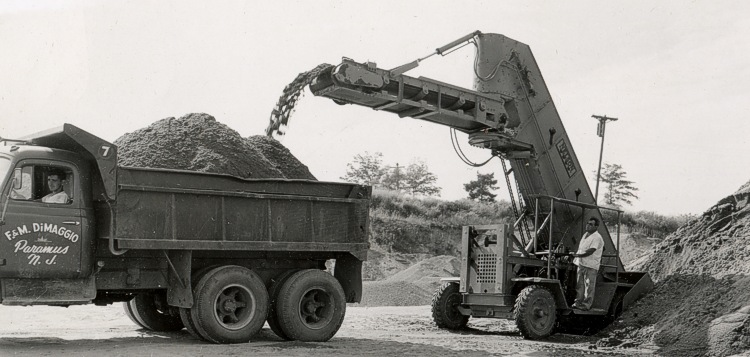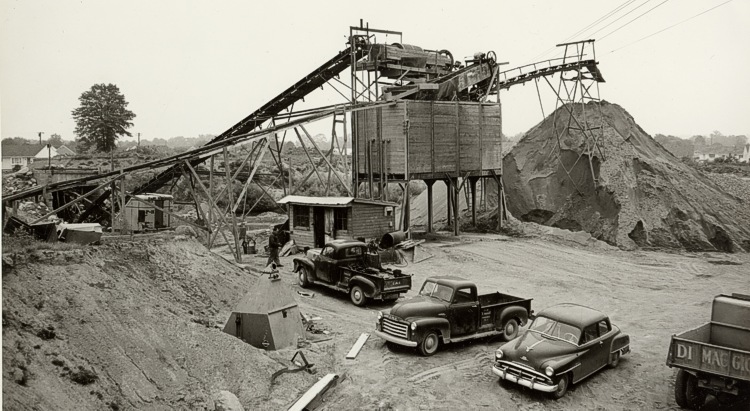
F & M DiMaggio, Inc., Paramus, NJ
|
I would often ask my father to wake me up so
I could go with him to the Sand Pit on Saturdays. He never woke me. Sometimes
I would wake up early enough to run downstairs before he left and ask him
to go. He would always make me ask my Mother before he would take me. I
would run back upstairs to ask my mother. My dad would stand at the bottom
of the stairs to hear her answer. "Yes he can go", she would yell, "But
make sure you get him breakfast". This was great news to me, you see it
meant we would stop at "Haglers" for breakfast, but that's another story.
The Sand Pit, as we called it, was a Sand and Gravel Wash Plant. They
processed mostly masons sand and gravel. Masons used the sand to make
mortar for Brick walls, and plaster for the walls inside the houses
they were building. Dirt was mined from different parts of the property,
trucked to a hopper which fed a Stone Crusher. The crusher, crushed large
stones down to smaller sizes, which could be sold. From the crusher, the
mixture of dirt, gravel and crushed stone would travel up a long, narrow
conveyor to a series of rotating screens at the top of the plant.
Here water, lots of water, was used to wash the material. |
There were two wells that supplied the water.. The larger pump would
deliver over 1,000 gallions a minute. The water carried off the light fine
silt and organic material and left clean gravel and coarse sand. Even in
the hotest days of summer, the water was cold and clear and always had
a great taste. There was a faucet by the old office where you could always
get a drink.
Deliveries were usually made in two international dump trucks. One was
a 'single' axle and the other a 'tandem' axle in the rear. The tandem axle
truck was much like the tractor portion of the 18 wheeler trailers we see
on the highways today, perhaps a little smaller back then. I always loved
the sound the tires the tandem truck made after it had delivered it's load
and was heading home down the highway home, and empty. It was sort of a
howling noise, like the truck was singing on it's way home.

Frank F. DiMaggio, Sr, driving the tandem axel truck and Uncle
Mickey, loading him
My uncle Mickey was always in on Saturdays, and if there were any deliveries
to make he would make them. As much as my father and his brother,
uncle Mickey, were alike, so they were different too. Uncle Mickey
would always seem to smile and laugh at things my dad saw no humor in.
Usually the source of the humor was something I had broken or lost.
Most of the deliveries were to construction sites, except Saturdays
we also delivered to private homes. Uncle Mickey always got out of
the truck and
talked to the home owner before backing the truck into the yard. "Always
ask if they have a cesspool or well before you back in", he would always
tell me. In the years to come, I would find out why.
There were two main highways in New Jersey back then, probably more,
but I only knew the two then. Route 4 and Route 17. The plant was just
off Rt. 17, on Glenn Avenue. All along these highways were
hot dog carts. On our way back to the plant we would pass one, then another.
Inevitably uncle Mickey would pull over to one and ask if I wanted a hot-dog.
I never said no, in fact I still can't say no to to a hot-dog!. Uncle
Mickey would always have cooked onions in red sauce on his and I had mustard
with sauerkraut. As soon as we had eaten the first one, he would look at
me, ask if I wanted another, then before I could answer, hold up two fingers
and motion for two more.
At the Plant there was a pot belly stove. It supplied heat as well as
made the coffee and was used to cook on. My Dad loved to cook. He
would often make peppers and eggs or potatoes
and eggs, one of my favorites. Upon returning to the plant, we'd pull up
to the office and head inside. The smell of food cooking permeated the
office. "Are you guys hungry?", Dad asked. Uncle Mickey looked at me, and
with a wink of the eye, turned to his brother and said " sure we're hungry"

|


